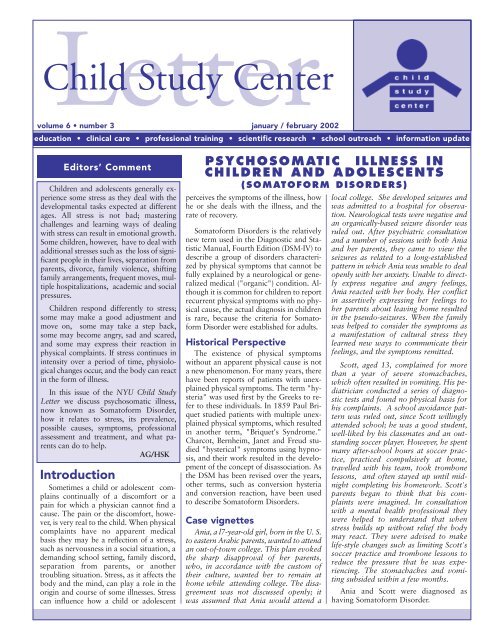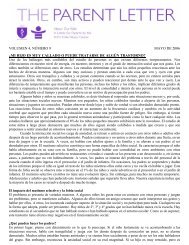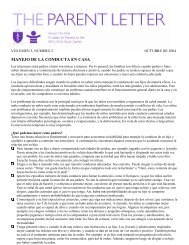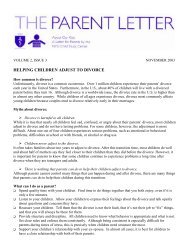Psychosomatic Illness in Children and ... - AboutOurKids.org
Psychosomatic Illness in Children and ... - AboutOurKids.org
Psychosomatic Illness in Children and ... - AboutOurKids.org
You also want an ePaper? Increase the reach of your titles
YUMPU automatically turns print PDFs into web optimized ePapers that Google loves.
Letter<br />
Child Study Center<br />
volume 6 • number 3 january / february 2002<br />
education • cl<strong>in</strong>ical care • professional tra<strong>in</strong><strong>in</strong>g • scientific research • school outreach • <strong>in</strong>formation update<br />
Editors’ Comment<br />
<strong>Children</strong> <strong>and</strong> adolescents generally experience<br />
some stress as they deal with the<br />
developmental tasks expected at different<br />
ages. All stress is not bad; master<strong>in</strong>g<br />
challenges <strong>and</strong> learn<strong>in</strong>g ways of deal<strong>in</strong>g<br />
with stress can result <strong>in</strong> emotional growth.<br />
Some children, however, have to deal with<br />
additional stresses such as the loss of significant<br />
people <strong>in</strong> their lives, separation from<br />
parents, divorce, family violence, shift<strong>in</strong>g<br />
family arrangements, frequent moves, multiple<br />
hospitalizations, academic <strong>and</strong> social<br />
pressures.<br />
<strong>Children</strong> respond differently to stress;<br />
some may make a good adjustment <strong>and</strong><br />
move on, some may take a step back,<br />
some may become angry, sad <strong>and</strong> scared,<br />
<strong>and</strong> some may express their reaction <strong>in</strong><br />
physical compla<strong>in</strong>ts. If stress cont<strong>in</strong>ues <strong>in</strong><br />
<strong>in</strong>tensity over a period of time, physiological<br />
changes occur, <strong>and</strong> the body can react<br />
<strong>in</strong> the form of illness.<br />
In this issue of the NYU Child Study<br />
Letter we discuss psychosomatic illness,<br />
now known as Somatoform Disorder,<br />
how it relates to stress, its prevalence,<br />
possible causes, symptoms, professional<br />
assessment <strong>and</strong> treatment, <strong>and</strong> what parents<br />
can do to help.<br />
AG/HSK<br />
Introduction<br />
Sometimes a child or adolescent compla<strong>in</strong>s<br />
cont<strong>in</strong>ually of a discomfort or a<br />
pa<strong>in</strong> for which a physician cannot f<strong>in</strong>d a<br />
cause. The pa<strong>in</strong> or the discomfort, however,<br />
is very real to the child. When physical<br />
compla<strong>in</strong>ts have no apparent medical<br />
basis they may be a reflection of a stress,<br />
such as nervousness <strong>in</strong> a social situation, a<br />
dem<strong>and</strong><strong>in</strong>g school sett<strong>in</strong>g, family discord,<br />
separation from parents, or another<br />
troubl<strong>in</strong>g situation. Stress, as it affects the<br />
body <strong>and</strong> the m<strong>in</strong>d, can play a role <strong>in</strong> the<br />
orig<strong>in</strong> <strong>and</strong> course of some illnesses. Stress<br />
can <strong>in</strong>fluence how a child or adolescent<br />
PSYCHOSOMATIC ILLNESS IN<br />
CHILDREN AND ADOLESCENTS<br />
(SOMATOFORM DISORDERS)<br />
perceives the symptoms of the illness, how<br />
he or she deals with the illness, <strong>and</strong> the<br />
rate of recovery.<br />
Somatoform Disorders is the relatively<br />
new term used <strong>in</strong> the Diagnostic <strong>and</strong> Statistic<br />
Manual, Fourth Edition (DSM-IV) to<br />
describe a group of disorders characterized<br />
by physical symptoms that cannot be<br />
fully expla<strong>in</strong>ed by a neurological or generalized<br />
medical ("<strong>org</strong>anic") condition. Although<br />
it is common for children to report<br />
recurrent physical symptoms with no physical<br />
cause, the actual diagnosis <strong>in</strong> children<br />
is rare, because the criteria for Somatoform<br />
Disorder were established for adults.<br />
Historical Perspective<br />
The existence of physical symptoms<br />
without an apparent physical cause is not<br />
a new phenomenon. For many years, there<br />
have been reports of patients with unexpla<strong>in</strong>ed<br />
physical symptoms. The term "hysteria"<br />
was used first by the Greeks to refer<br />
to these <strong>in</strong>dividuals. In 1859 Paul Briquet<br />
studied patients with multiple unexpla<strong>in</strong>ed<br />
physical symptoms, which resulted<br />
<strong>in</strong> another term, "Briquet's Syndrome."<br />
Charcot, Bernheim, Janet <strong>and</strong> Freud studied<br />
"hysterical" symptoms us<strong>in</strong>g hypnosis,<br />
<strong>and</strong> their work resulted <strong>in</strong> the development<br />
of the concept of disassociation. As<br />
the DSM has been revised over the years,<br />
other terms, such as conversion hysteria<br />
<strong>and</strong> conversion reaction, have been used<br />
to describe Somatoform Disorders.<br />
Case vignettes<br />
Ania, a l7-year-old girl, born <strong>in</strong> the U. S.<br />
to eastern Arabic parents, wanted to attend<br />
an out-of-town college. This plan evoked<br />
the sharp disapproval of her parents,<br />
who, <strong>in</strong> accordance with the custom of<br />
their culture, wanted her to rema<strong>in</strong> at<br />
home while attend<strong>in</strong>g college. The disagreement<br />
was not discussed openly; it<br />
was assumed that Ania would attend a<br />
local college. She developed seizures <strong>and</strong><br />
was admitted to a hospital for observation.<br />
Neurological tests were negative <strong>and</strong><br />
an <strong>org</strong>anically-based seizure disorder was<br />
ruled out. After psychiatric consultation<br />
<strong>and</strong> a number of sessions with both Ania<br />
<strong>and</strong> her parents, they came to view the<br />
seizures as related to a long-established<br />
pattern <strong>in</strong> which Ania was unable to deal<br />
openly with her anxiety. Unable to directly<br />
express negative <strong>and</strong> angry feel<strong>in</strong>gs,<br />
Ania reacted with her body. Her conflict<br />
<strong>in</strong> assertively express<strong>in</strong>g her feel<strong>in</strong>gs to<br />
her parents about leav<strong>in</strong>g home resulted<br />
<strong>in</strong> the pseudo-seizures. When the family<br />
was helped to consider the symptoms as<br />
a manifestation of cultural stress they<br />
learned new ways to communicate their<br />
feel<strong>in</strong>gs, <strong>and</strong> the symptoms remitted.<br />
Scott, aged 13, compla<strong>in</strong>ed for more<br />
than a year of severe stomachaches,<br />
which often resulted <strong>in</strong> vomit<strong>in</strong>g. His pediatrician<br />
conducted a series of diagnostic<br />
tests <strong>and</strong> found no physical basis for<br />
his compla<strong>in</strong>ts. A school avoidance pattern<br />
was ruled out, s<strong>in</strong>ce Scott will<strong>in</strong>gly<br />
attended school; he was a good student,<br />
well-liked by his classmates <strong>and</strong> an outst<strong>and</strong><strong>in</strong>g<br />
soccer player. However, he spent<br />
many after-school hours at soccer practice,<br />
practiced compulsively at home,<br />
travelled with his team, took trombone<br />
lessons, <strong>and</strong> often stayed up until midnight<br />
complet<strong>in</strong>g his homework. Scott's<br />
parents began to th<strong>in</strong>k that his compla<strong>in</strong>ts<br />
were imag<strong>in</strong>ed. In consultation<br />
with a mental health professional they<br />
were helped to underst<strong>and</strong> that when<br />
stress builds up without relief the body<br />
may react. They were advised to make<br />
life-style changes such as limit<strong>in</strong>g Scott's<br />
soccer practice <strong>and</strong> trombone lessons to<br />
reduce the pressure that he was experienc<strong>in</strong>g.<br />
The stomachaches <strong>and</strong> vomit<strong>in</strong>g<br />
subsided with<strong>in</strong> a few months.<br />
Ania <strong>and</strong> Scott were diagnosed as<br />
hav<strong>in</strong>g Somatoform Disorder.
education • cl<strong>in</strong>ical care • professional tra<strong>in</strong><strong>in</strong>g • scientific research • school outreach • <strong>in</strong>formation update<br />
SCHOOL OF<br />
MEDICINE<br />
NEW YORK UNIVERSITY<br />
Kenneth G. Langone<br />
Chairman, Foundation Board of Trustees<br />
Robert M. Glickman, M.D.<br />
Dean<br />
NYU School of Medic<strong>in</strong>e<br />
Editorial Board<br />
Harold S. Koplewicz, M.D., Found<strong>in</strong>g Editor<br />
Arnold <strong>and</strong> Debbie Simon Professor of Child<br />
<strong>and</strong> Adolescent Psychiatry<br />
Director of the Child Study Center<br />
New York University School of Medic<strong>in</strong>e<br />
Anita Gurian, Ph.D., Editor<br />
Executive Editor, www.<strong>AboutOurKids</strong>.<strong>org</strong><br />
Cl<strong>in</strong>ical Assistant Professor<br />
New York University School of Medic<strong>in</strong>e<br />
Howard Abikoff, Ph.D.<br />
Pevaroff-Cohn Professor of Psychiatry<br />
Director of Research<br />
Child Study Center<br />
New York University School of Medic<strong>in</strong>e<br />
Robert Cancro, M.D.<br />
Professor <strong>and</strong> Chairman<br />
Department of Psychiatry<br />
New York University School of Medic<strong>in</strong>e<br />
Gabrielle A. Carlson, M.D.<br />
Professor of Psychiatry <strong>and</strong> Pediatrics<br />
New York State University at Stony Brook<br />
Stella Chess, M.D.<br />
Professor of Child Psychiatry<br />
New York University School of Medic<strong>in</strong>e<br />
Gail Furman, Ph.D.<br />
Women’s Commission on Refugee<br />
Women <strong>and</strong> <strong>Children</strong>, United Nations<br />
Glenn S. Hirsch, M.D.<br />
Assistant Professor of Cl<strong>in</strong>ical Psychiatry<br />
Deputy Director, Child Study Center<br />
Medical Director, Division of Child <strong>and</strong><br />
Adolescent Psychiatry<br />
New York University School of Medic<strong>in</strong>e<br />
Rachel Kle<strong>in</strong>, Ph.D.<br />
Professor of Psychiatry<br />
New York University School of Medic<strong>in</strong>e<br />
Maria Kovacs, Ph.D.<br />
Professor of Psychiatry<br />
University of Pittsburgh School of Medic<strong>in</strong>e<br />
Wade P. Parks, M.D., Ph.D.<br />
Professor <strong>and</strong> Chairman<br />
Department of Pediatrics<br />
New York University School of Medic<strong>in</strong>e<br />
Alex<strong>and</strong>er Thomas, M.D.<br />
Professor of Psychiatry<br />
New York University School of Medic<strong>in</strong>e<br />
What are the symptoms?<br />
Young children typically compla<strong>in</strong> of vague<br />
symptoms; school-age children are better<br />
able to localize their pa<strong>in</strong>, <strong>and</strong> adolescents<br />
can describe their pa<strong>in</strong> <strong>in</strong> detail. Many<br />
compla<strong>in</strong>ts are short-lived, but when a<br />
child compla<strong>in</strong>s repeatedly, <strong>and</strong> a physician<br />
can f<strong>in</strong>d no physical basis for the<br />
compla<strong>in</strong>t, the child may have a Somatoform<br />
Disorder. The recurrent symptoms<br />
commonly reported by children <strong>and</strong><br />
adolescents are:<br />
• Headaches<br />
• Stomachs <strong>and</strong> abdom<strong>in</strong>al distress<br />
• With the hormonal changes of<br />
puberty, anxiety <strong>and</strong> worry, fatigue,<br />
loss of appetite, aches <strong>and</strong> pa<strong>in</strong> are<br />
frequent symptoms, more prevalent <strong>in</strong><br />
girls than boys<br />
• Symptoms that mimic neurological<br />
disorders, such as double vision, poor<br />
balance <strong>and</strong> coord<strong>in</strong>ation, paralysis,<br />
seizures<br />
• Imag<strong>in</strong>ed physical deformities or<br />
defects<br />
• Back pa<strong>in</strong><br />
• Fatigue<br />
• Sore muscles<br />
Academic problems, school refusal,<br />
social withdrawal, anxiety <strong>and</strong><br />
behavioral problems often accompany<br />
<strong>and</strong> may trigger Somatoform Disorders.<br />
How is Somatoform Disorder<br />
diagnosed?<br />
In order to meet the criteria for a diagnosis<br />
of Somatoform Disorder <strong>in</strong> the<br />
DSM-IV, the person must demonstrate a<br />
pattern of recurr<strong>in</strong>g, multiple, cl<strong>in</strong>ically<br />
significant physical compla<strong>in</strong>ts, the symptoms<br />
of which are NOT produced voluntarily.<br />
(See the description of Scott above.)<br />
Somatoform Disorder must not be due<br />
to other disorders <strong>and</strong> must be dist<strong>in</strong>guished<br />
from Mal<strong>in</strong>ger<strong>in</strong>g or Factitious<br />
Disorder, which are both characterized<br />
by consciously or purposely produced<br />
symptoms. Some children who suffer<br />
from Posttraumatic Stress Disorder after<br />
a traumatic event report pa<strong>in</strong>; this pa<strong>in</strong> is<br />
acute rather than chronic <strong>and</strong> is accompanied<br />
by nightmares, <strong>in</strong>trusive thoughts<br />
<strong>and</strong> re-experienc<strong>in</strong>g of the event that was<br />
the source of stress. <strong>Children</strong> who had<br />
Somatoform Disorder before experienc<strong>in</strong>g<br />
a traumatic event may compla<strong>in</strong><br />
more frequently <strong>and</strong> the severity of their<br />
compla<strong>in</strong>ts may <strong>in</strong>tensify.<br />
Types of Somatoform<br />
Disorders diagnosed <strong>in</strong><br />
children (DSM-IV)<br />
Conversion Disorder is the most common<br />
type diagnosed <strong>in</strong> children. (See the<br />
description of Ania above.) Conversion<br />
Disorder <strong>in</strong>volves unexpla<strong>in</strong>ed symptoms<br />
or deficits affect<strong>in</strong>g voluntary motor or<br />
sensory function that are suggestive of a<br />
neurological or other general medical condition.<br />
The symptoms resemble neurological<br />
conditions <strong>and</strong> physical ailments such<br />
as bl<strong>in</strong>dness, seizures, gait imbalance,<br />
paralysis, tunnel vision <strong>and</strong> numbness.<br />
<strong>Children</strong> may compla<strong>in</strong> of weakness; they<br />
may have trouble walk<strong>in</strong>g, talk<strong>in</strong>g, or hear<strong>in</strong>g.<br />
Trauma <strong>and</strong> abuse <strong>in</strong>crease the likelihood<br />
of Conversion Disorder, which is<br />
usually triggered by psychological factors.<br />
Somatization Disorder is a disorder that<br />
beg<strong>in</strong>s before age 30 years, extends over a<br />
period of years, <strong>and</strong> is characterized by a<br />
comb<strong>in</strong>ation of pa<strong>in</strong>, gastro<strong>in</strong>test<strong>in</strong>al, sexual<br />
<strong>and</strong> pseudoneurological symptoms.<br />
This chronic, recurrent disorder with multiple<br />
compla<strong>in</strong>ts is often presented <strong>in</strong> a dramatic<br />
<strong>and</strong> exaggerated way. Although<br />
somatic compla<strong>in</strong>ts <strong>in</strong> children are common,<br />
a formal diagnosis is difficult because<br />
of the criteria regard<strong>in</strong>g sexual symptoms.<br />
Body Dysmorphic Disorder is the preoccupation<br />
with an imag<strong>in</strong>ed or exaggerated<br />
defect <strong>in</strong> physical appearance<br />
which causes significant distress or impairment<br />
<strong>in</strong> social, occupational, or other<br />
important areas of function<strong>in</strong>g.<br />
Hypochondriasis is the preoccupation<br />
with the fear of hav<strong>in</strong>g, or the idea that<br />
one has, a serious disease based on the<br />
person's mis<strong>in</strong>terpretation of bodily<br />
symptoms or bodily functions.<br />
Pa<strong>in</strong> Disorder has limited usefulness <strong>in</strong><br />
children s<strong>in</strong>ce there are few studies to<br />
dist<strong>in</strong>guish it from Conversion Disorder.<br />
Pa<strong>in</strong> Disorder is characterized by pa<strong>in</strong> as<br />
the predom<strong>in</strong>ant focus of cl<strong>in</strong>ical attention.<br />
In addition, psychological factors<br />
have an important role <strong>in</strong> the onset,<br />
severity, exacerbation, or ma<strong>in</strong>tenance.<br />
Undifferentiated Somatoform Disorder<br />
is characterized by unexpla<strong>in</strong>ed physical<br />
compla<strong>in</strong>ts, last<strong>in</strong>g at least 6 months, that<br />
are below the threshold for a diagnosis of<br />
Somatization Disorder. When somatoform<br />
symptoms do not meet the criteria for any<br />
of the specific Somatoform Disorders, a<br />
Somatoform Disorder Not Otherwise Specified<br />
is utilized.
education • cl<strong>in</strong>ical care • professional tra<strong>in</strong><strong>in</strong>g • scientific research • school outreach • <strong>in</strong>formation update<br />
Prevalence of Somatoform<br />
Disorders<br />
Studies show conflict<strong>in</strong>g evidence regard<strong>in</strong>g<br />
the occurrence of Somatoform Disorders.<br />
In a child psychiatric outpatient<br />
study, rates ranged from 1.3 to 5%. In a<br />
general population study, somatic compla<strong>in</strong>ts<br />
were found <strong>in</strong> 11% of girls, <strong>and</strong> 4%<br />
of boys. Adult studies show .2 - 2% <strong>in</strong> women<br />
<strong>and</strong> less than .2% <strong>in</strong> men. Somatoform<br />
disorders are believed to occur<br />
more often <strong>in</strong> less sophisticated or less educated<br />
populations <strong>and</strong> lower SES groups.<br />
In terms of gender differences there is a 5:1<br />
female-male ratio. Studies of prepubertal<br />
children report an equal ratio <strong>in</strong> boys <strong>and</strong><br />
girls; <strong>in</strong> post-puberty, however, the female<br />
<strong>in</strong>cidence <strong>in</strong>creases.<br />
Causes<br />
<strong>Children</strong> react differently to stress, depend<strong>in</strong>g<br />
on <strong>in</strong>dividual personal characteristics,<br />
such as their appraisal of the event<br />
<strong>and</strong> their cop<strong>in</strong>g strategies. Certa<strong>in</strong> children<br />
have more difficulty <strong>in</strong> express<strong>in</strong>g<br />
their emotions directly, due to their<br />
<strong>in</strong>dividual temperament, the emotional<br />
climate of the family, <strong>and</strong> cultural<br />
customs. The most common triggers of<br />
Somatoform Disorders are psychosocial<br />
stressors, such as a death <strong>in</strong> the family,<br />
trauma (physical or sexual abuse) or family<br />
conflict. The specific orig<strong>in</strong>s of Somatoform<br />
Disorder are as yet unknown, although<br />
there are a number of theories.<br />
l) Psychosocial theory views the<br />
symptoms as social communication to<br />
express emotions or to symbolize<br />
feel<strong>in</strong>gs than cannot be verbalized.<br />
2) A psychodynamic <strong>in</strong>terpretation views<br />
symptoms as repressed <strong>in</strong>st<strong>in</strong>ctual<br />
impulses. <strong>Psychosomatic</strong> pa<strong>in</strong>s are<br />
believed to be the bodily expressions of<br />
underly<strong>in</strong>g <strong>and</strong> unresolved emotional<br />
issues – pa<strong>in</strong>ful memories, unconscious<br />
conflicts, sometimes sexual abuse.<br />
3) Biological studies suggest the <strong>in</strong>dividual<br />
may have a faulty perception <strong>and</strong><br />
assessment of sensory <strong>in</strong>puts.<br />
4) Genetic data suggest that somatoform<br />
disorders tend to run <strong>in</strong> families with<br />
an occurrence of 10 - 20% of first degree<br />
female relatives. Other evidence<br />
shows that anxiety <strong>and</strong> depression are<br />
more common <strong>in</strong> the families of somatiz<strong>in</strong>g<br />
children. Parents of children<br />
with recurrent abdom<strong>in</strong>al pa<strong>in</strong> reported<br />
more psychiatric symptoms.<br />
Treatment<br />
A professional assessment is the first<br />
step <strong>in</strong> treat<strong>in</strong>g a child who may have a<br />
Somatoform Disorder. The professional<br />
conduct<strong>in</strong>g the assessment will generally<br />
perform the follow<strong>in</strong>g procedures:<br />
l) Conduct a complete <strong>in</strong>itial workup of the<br />
symptoms, <strong>in</strong>clud<strong>in</strong>g a physical exam.<br />
2) Exam<strong>in</strong>e the child without the parent<br />
present <strong>and</strong> note if there are any<br />
changes <strong>in</strong> the child's behavior.<br />
3) Obta<strong>in</strong> a psychosocial history, <strong>in</strong>clud<strong>in</strong>g<br />
<strong>in</strong>formation about possible stressors, <strong>in</strong><br />
order to differentiate the symptoms<br />
from other disorders.<br />
4) Inform the family of the importance of<br />
psychological factors which may<br />
contribute to the symptoms <strong>and</strong> the<br />
plan to manage them.<br />
5) Discuss the advisability of an <strong>in</strong>-depth<br />
psychiatric or psychological evaluation<br />
to assist <strong>in</strong> underst<strong>and</strong><strong>in</strong>g the symptoms<br />
picture <strong>and</strong> causes.<br />
Intervention procedures may <strong>in</strong>clude<br />
the follow<strong>in</strong>g.<br />
l) Communication with the primary care<br />
physician to be clear <strong>and</strong> to avoid duplication<br />
of services <strong>and</strong> tests <strong>and</strong> the<br />
transmission of contradictory <strong>in</strong>formation<br />
to the family.<br />
2) Education of the child regard<strong>in</strong>g the<br />
<strong>in</strong>terpretation of bodily sensations.<br />
3) Development <strong>and</strong> re<strong>in</strong>forcement of cop<strong>in</strong>g<br />
behaviors that reduce the positive<br />
ga<strong>in</strong> associated with the sick role<br />
through <strong>in</strong>dividual, family, group <strong>and</strong><br />
cognitive behavior therapies. Relaxation<br />
<strong>and</strong> biofeedback techniques are useful.<br />
4) Identification <strong>and</strong> appropriate treatment<br />
of co-exist<strong>in</strong>g diagnoses, i.e., anxiety,<br />
depression.<br />
5) When <strong>in</strong>dicated, medication management<br />
with SSRIs (Selective Seroton<strong>in</strong><br />
Reuptake Inhibitors), tricyclics, anxiolytics,<br />
stimulant <strong>and</strong> mood stabilizers is<br />
effective.<br />
How parents can help<br />
Take your child's compla<strong>in</strong>ts seriously.<br />
Remember that a child who compla<strong>in</strong>s<br />
may have a real physical illness. Consultation<br />
with a physician is imperative. If,<br />
after a physical checkup, the child's compla<strong>in</strong>ts<br />
– headaches, stomach aches, motor<br />
coord<strong>in</strong>ation, back pa<strong>in</strong>, eat<strong>in</strong>g or sleep<strong>in</strong>g<br />
difficulties, or other problems – persist <strong>and</strong><br />
<strong>in</strong>terfere with daily personal <strong>and</strong> academic<br />
function<strong>in</strong>g, be aware that the symptoms<br />
are not produced <strong>in</strong>tentionally, but may be<br />
emotionally-based. Adolescents may<br />
attempt to self-medicate with alcohol or<br />
drugs.<br />
Encourage your child to express her<br />
pa<strong>in</strong> verbally. Reassure her that you are<br />
aware that the pa<strong>in</strong> is real <strong>and</strong> that ways<br />
can be found to alleviate it. Expla<strong>in</strong> that<br />
pressure <strong>and</strong> worry can cause physical<br />
problems. Emphasize that the pa<strong>in</strong> is not<br />
punishment <strong>and</strong> not her fault, <strong>and</strong> that<br />
stress can affect the body <strong>in</strong> different ways.<br />
Underst<strong>and</strong> that the perception of pa<strong>in</strong><br />
is affected by a variety of factors, <strong>in</strong>clud<strong>in</strong>g<br />
the age of the child as well as her<br />
basic temperamental style, psychological<br />
state <strong>and</strong> <strong>in</strong>dividual experience. Infants<br />
<strong>and</strong> young children react to pa<strong>in</strong> by cry<strong>in</strong>g<br />
<strong>and</strong> physical gestures. As children grow<br />
older, they will have more experience with<br />
pa<strong>in</strong> <strong>and</strong> will have developed cop<strong>in</strong>g<br />
strategies. By adolescence most youngsters<br />
have a mature underst<strong>and</strong><strong>in</strong>g of pa<strong>in</strong> <strong>and</strong><br />
its significance.<br />
Try to p<strong>in</strong>po<strong>in</strong>t potential causes. Your<br />
child may be experienc<strong>in</strong>g academic<br />
pressure, family conflict, a change <strong>in</strong><br />
school, a move, the illness or death of a family<br />
member or friend, or physical or<br />
sexual abuse. She may have had traumatic<br />
experiences you have not known about.<br />
Devise ways to give the child a sense of<br />
control. For some children, keep<strong>in</strong>g a log<br />
will help identify the specific situations<br />
which cause stress <strong>and</strong> those which result<br />
<strong>in</strong> relief. For example, have the child<br />
record when the pa<strong>in</strong> occurs <strong>in</strong> relation to<br />
activities, time of day, playdates or other<br />
social occasions, how long the pa<strong>in</strong> lasts,<br />
what alleviates it. This <strong>in</strong>formation will<br />
help <strong>in</strong> plann<strong>in</strong>g appropriate life changes,<br />
such as a modification of school dem<strong>and</strong>s,<br />
adjustment <strong>in</strong> family relationships, modification<br />
of an overly crowded schedule of<br />
activities, <strong>and</strong> may alleviate a possible<br />
source of stress.<br />
Be careful not to <strong>in</strong>advertently re<strong>in</strong>force<br />
the behavior by becom<strong>in</strong>g visibly alarmed<br />
<strong>and</strong> overly solicitous. For example, allow<strong>in</strong>g<br />
your child to stay home or to avoid<br />
social situations may re<strong>in</strong>force the<br />
behavior.
education • cl<strong>in</strong>ical care • professional tra<strong>in</strong><strong>in</strong>g • scientific research • school outreach • <strong>in</strong>formation update<br />
Be a good role model. Exam<strong>in</strong>e your<br />
own ways of deal<strong>in</strong>g with stress to see if<br />
you also tend to express emotional<br />
conflicts through physical compla<strong>in</strong>ts <strong>and</strong><br />
take steps to change this pattern of<br />
response.<br />
If improvement does not occur, <strong>and</strong><br />
your child is gett<strong>in</strong>g appropriate medical<br />
treatment, consultation with a mental<br />
health professional is warranted.<br />
ABOUT THE AUTHOR<br />
Melv<strong>in</strong> D. Oatis, M.D., is Assistant<br />
Professor of Psychiatry at the NYU School<br />
of Medic<strong>in</strong>e <strong>and</strong> the Director of the<br />
Pediatric Consultation <strong>and</strong> Liaison Service,<br />
which provides diagnostic evaluations<br />
<strong>and</strong> treatment, <strong>in</strong>clud<strong>in</strong>g medication<br />
<strong>and</strong> therapy. In addition to Somatoform<br />
Disorders, Dr. Oatis's <strong>in</strong>terests <strong>in</strong>clude<br />
psychopharmacologic research regard<strong>in</strong>g<br />
anxiety <strong>and</strong> ADHD <strong>and</strong> teach<strong>in</strong>g medical<br />
students <strong>and</strong> residents <strong>in</strong> adult <strong>and</strong> child<br />
psychiatry.<br />
REFERENCES<br />
American Psychiatric Association (1994)<br />
Diagnostic <strong>and</strong> Statistical Manual of Mental<br />
Disorders (4th ed.). Wash<strong>in</strong>gton, DC:<br />
American Psychiatric Press.<br />
Behrman, RE, Kliegman, R & Jenson, HB<br />
(Eds.) (2000) Nelson Textbook of Pediatrics<br />
(16th ed.). Philadelphia: W.B. Saunders & Co.<br />
Lewis, M. (Ed.) (1991) Child <strong>and</strong> Adolescent<br />
Psychiatry: A Comprehensive Textbook.<br />
Baltimore: Williams <strong>and</strong> Wilk<strong>in</strong>s.<br />
Sadock, BJ & Sadock, VA (Eds.) (2000)<br />
Kaplan & Sadock’s Comprehensive<br />
Textbook of Psychiatry (7th ed.). Baltimore:<br />
Lipp<strong>in</strong>cott, Williams & Wilk<strong>in</strong>s Publishers.<br />
Campo, JV & Fritsch, SL (1994)<br />
Somatization <strong>in</strong> children <strong>and</strong> adolescents.<br />
Journal of the American Academy of Child<br />
& Adolescent Psychiatry. 33, 1223-1235.<br />
Leslie, SA (1988) Diagnosis <strong>and</strong> treatment of<br />
hysterical conversion reactions. Archives of<br />
Disease <strong>in</strong> Childhood. 63, 506-511.<br />
Letter<br />
Child Study Center<br />
550 First Avenue New York, NY 10016 (212)263-6622<br />
The NYU Child Study Center Letter is published five times annually.<br />
RELATED ARTICLES<br />
About Anxiety Disorders<br />
<strong>AboutOurKids</strong>.<strong>org</strong>/articles/about_anxiety.html<br />
About Body Dysmorphic Disorder<br />
<strong>AboutOurKids</strong>.<strong>org</strong>/articles/about_bdd.html<br />
About Depressive Disorders<br />
<strong>AboutOurKids</strong>.<strong>org</strong>/articles/about_<br />
depressive.html<br />
About Posttraumatic Stress Disorder<br />
<strong>AboutOurKids</strong>.<strong>org</strong>/articles/about_ptsd.html<br />
Choos<strong>in</strong>g a Mental Health Professional<br />
<strong>AboutOurKids</strong>.<strong>org</strong>/articles/choos<strong>in</strong>gmh.html<br />
CSC Letter: <strong>Children</strong> with a Chronic<br />
<strong>Illness</strong>: The Interface of Medic<strong>in</strong>e <strong>and</strong><br />
Mental Health<br />
<strong>AboutOurKids</strong>.<strong>org</strong>/letter/<strong>in</strong>dex.html<br />
Guide to Psychiatric Medications for<br />
<strong>Children</strong> <strong>and</strong> Adolescents<br />
<strong>AboutOurKids</strong>.<strong>org</strong>/articles/guidetopsychme<br />
ds.html<br />
Stress <strong>in</strong> <strong>Children</strong>: What It Is, How Parents<br />
Can Help<br />
<strong>AboutOurKids</strong>.<strong>org</strong>/articles/stress.html<br />
Underst<strong>and</strong><strong>in</strong>g School Refusal<br />
<strong>AboutOurKids</strong>.<strong>org</strong>/articles/refusal.html<br />
SCHOOL OF<br />
MEDICINE<br />
NEW YORK UNIVERSITY





